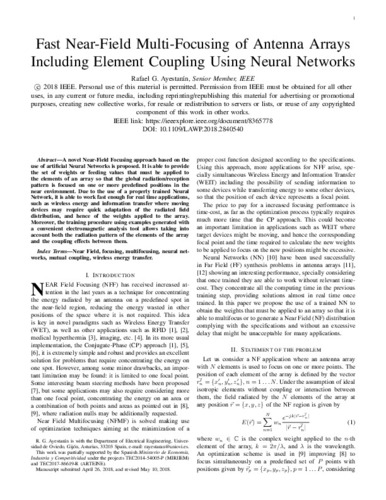Fast Near-Field Multi-Focusing of Antenna Arrays Including Element Coupling Using Neural Networks
Autor(es) y otros:
Palabra(s) clave:
Comunicaciones
Antenas
Redes neuronales
Síntesis
Fecha de publicación:
Editorial:
IEEE
Versión del editor:
Citación:
Descripción física:
Resumen:
A novel near-field focusing approach based on the use of artificial neural networks (NNs) is proposed. It is able to provide the set of weights or feeding values that must be applied to the elements of an array so that the global radiation/reception pattern is focused on one or more predefined positions in the near environment. Due to the use of a properly trained NN, it is able to work fast enough for real-time applications, such as wireless energy and information transfer where moving devices may require quick adaptation of the radiated field distribution and, hence, of the weights applied to the array. Moreover, the training procedure using examples generated with a convenient electromagnetic analysis tool allows taking into account both the radiation pattern of the elements of the array and the coupling effects between them.
A novel near-field focusing approach based on the use of artificial neural networks (NNs) is proposed. It is able to provide the set of weights or feeding values that must be applied to the elements of an array so that the global radiation/reception pattern is focused on one or more predefined positions in the near environment. Due to the use of a properly trained NN, it is able to work fast enough for real-time applications, such as wireless energy and information transfer where moving devices may require quick adaptation of the radiated field distribution and, hence, of the weights applied to the array. Moreover, the training procedure using examples generated with a convenient electromagnetic analysis tool allows taking into account both the radiation pattern of the elements of the array and the coupling effects between them.
Patrocinado por:
This work was partially supported by the Spanish Ministerio de Econom´ıa, Industria y Competitividad under the projects TEC2014-54005-P (MIRIIEM) and TEC2017-86619-R (ARTEINE).
Colecciones
Ficheros en el ítem




